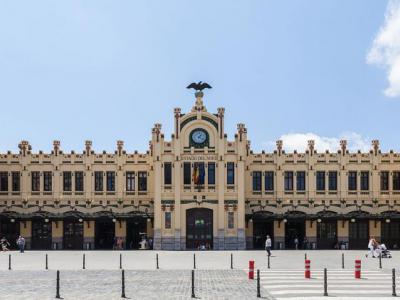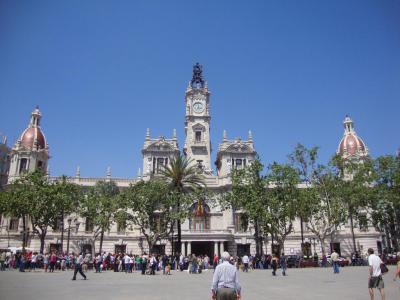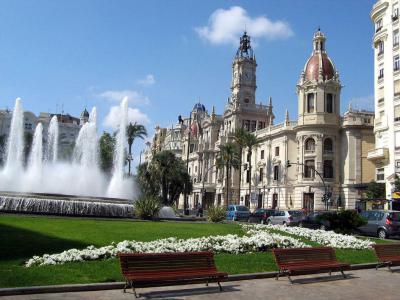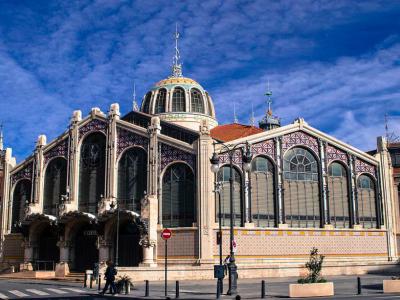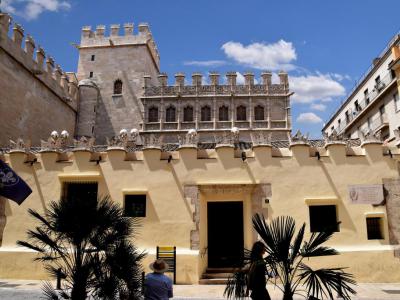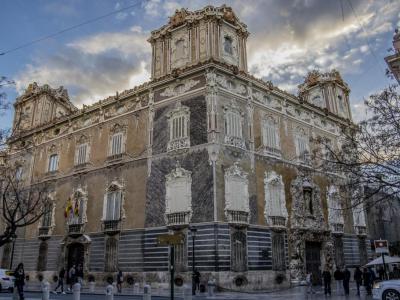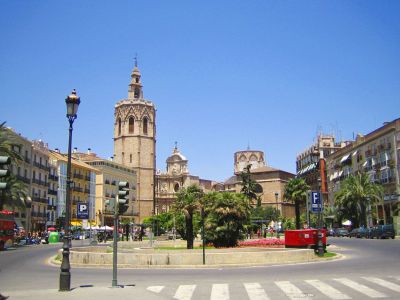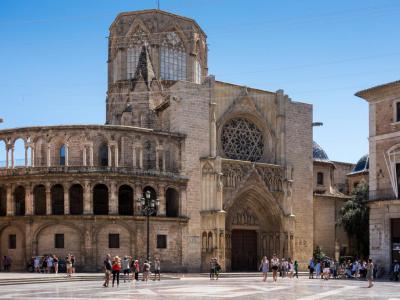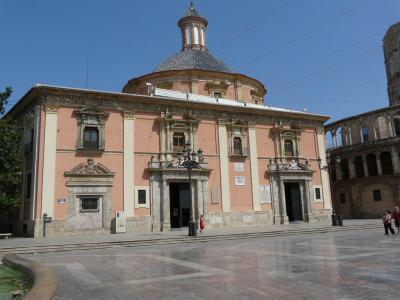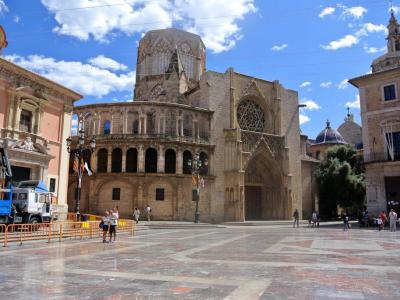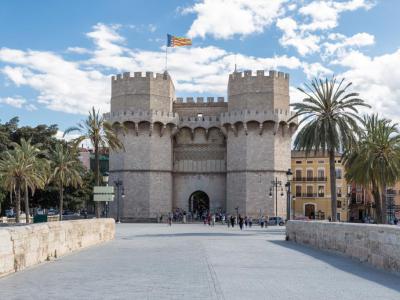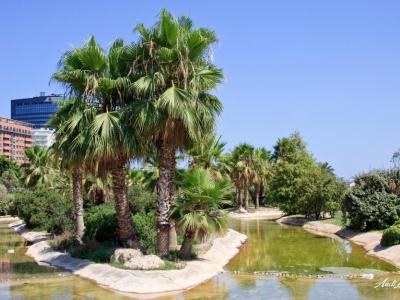Audio Guide: Valencia Introduction Walking Tour (Self Guided), Valencia
Valencia, Spain’s third-largest city, carries a rich history that stretches back to 138 BC, when it was founded as a Roman colony for battle-tested veterans. Known then as “Valentia”, meaning “valor,” it honored the courage of its first inhabitants. The city was destroyed in 75 BC by Pompey the Great but was rebuilt within a century, eventually becoming home to Visigoths and later the Moors, who transformed the region with new crops and ingenious irrigation systems. Then, in 1238, Aragonese Christians took control, declaring Valencia the capital of their kingdom.
The 15th century marked a true Golden Age. Trade with the Iberian Peninsula, Italy, and the wider Mediterranean fueled immense growth. By the century’s end, Valencia ranked among Europe’s largest cities. A striking reminder of this prosperous era is the magnificent Silk Exchange-a Gothic structure now recognized as a UNESCO World Heritage Site.
The city’s historic heart is packed with highlights. The Valencia Cathedral houses what many believe to be the Holy Grail, and from the top of the Miguelete Tower, you’ll get sweeping views of the rooftops below. Nearby, Queen’s Plaza and Virgin Square offer lively spots to relax and take in the surrounding architecture. The Central Market, one of the largest in Europe, is a feast for the senses-bursting with local flavors, colors, and aromas.
Visitors are often drawn by the city’s fusion of old and new architecture. For a glimpse of medieval Valencia, head to the Serranos Towers, or lose yourself in the maze of narrow lanes where tucked-away churches and small museums tell quieter stories.
If you need a break, the Turia Garden offers a breath of fresh air. Set in a former riverbed, this expansive park winds through the city like a green ribbon.
Even a short visit to Valencia leaves a lasting impression. To maximize your visit, don your walking shoes and embark on this self-guided tour-an ideal way to experience this remarkable Spanish city, with the GPSmyCity app as your guide.
The 15th century marked a true Golden Age. Trade with the Iberian Peninsula, Italy, and the wider Mediterranean fueled immense growth. By the century’s end, Valencia ranked among Europe’s largest cities. A striking reminder of this prosperous era is the magnificent Silk Exchange-a Gothic structure now recognized as a UNESCO World Heritage Site.
The city’s historic heart is packed with highlights. The Valencia Cathedral houses what many believe to be the Holy Grail, and from the top of the Miguelete Tower, you’ll get sweeping views of the rooftops below. Nearby, Queen’s Plaza and Virgin Square offer lively spots to relax and take in the surrounding architecture. The Central Market, one of the largest in Europe, is a feast for the senses-bursting with local flavors, colors, and aromas.
Visitors are often drawn by the city’s fusion of old and new architecture. For a glimpse of medieval Valencia, head to the Serranos Towers, or lose yourself in the maze of narrow lanes where tucked-away churches and small museums tell quieter stories.
If you need a break, the Turia Garden offers a breath of fresh air. Set in a former riverbed, this expansive park winds through the city like a green ribbon.
Even a short visit to Valencia leaves a lasting impression. To maximize your visit, don your walking shoes and embark on this self-guided tour-an ideal way to experience this remarkable Spanish city, with the GPSmyCity app as your guide.
How it works: Download the app "GPSmyCity: Walks in 1K+ Cities" from Apple App Store or Google Play Store to your mobile phone or tablet. The app turns your mobile device into a personal tour guide and its built-in GPS navigation functions guide you from one tour stop to next. The app works offline, so no data plan is needed when traveling abroad.
Valencia Introduction Walking Tour Map
Guide Name: Valencia Introduction Walking Tour
Guide Location: Spain » Valencia (See other walking tours in Valencia)
Guide Type: Self-guided Walking Tour (Sightseeing)
# of Attractions: 12
Tour Duration: 2 Hour(s)
Travel Distance: 3.2 Km or 2 Miles
Author: DanaOffice
Sight(s) Featured in This Guide:
Guide Location: Spain » Valencia (See other walking tours in Valencia)
Guide Type: Self-guided Walking Tour (Sightseeing)
# of Attractions: 12
Tour Duration: 2 Hour(s)
Travel Distance: 3.2 Km or 2 Miles
Author: DanaOffice
Sight(s) Featured in This Guide:
- Estacion del Norte (North Railway Station)
- Ayuntamiento (Town Hall)
- Plaza del Ayuntamiento (Town Hall Plaza)
- Mercado Central (Central Market)
- Lonja de la Seda (The Silk Exchange)
- Museo Nacional de Ceramica (National Museum of Ceramics)
- Plaza de la Reina (Queen's Plaza)
- La Catedral (Valencia Cathedral)
- Basilica de la Virgen de los Desamparados (Basilica of Our Lady of the Forsaken)
- Plaza de la Virgen (Virgin Plaza)
- Torres de Serranos (Serranos Towers)
- Jardin del Turia (Turia Garden)
1) Estacion del Norte (North Railway Station) (must see)
Valencia’s North Railway Station isn’t just a hub for travelers-it’s a destination in its own right. As the city’s main train terminal, it offers daily connections to Spanish cities like Barcelona and Madrid, as well as routes reaching the French border. But even if you’re not boarding a train, stepping inside is well worth your time.
Completed in the early 20th century, the building is a shining example of Modernista architecture-Spain’s answer to Art Nouveau. With its clean symmetry and regional flair, it blends function and elegance. The façade features vibrant mosaics and decorative elements that reflect the spirit and color of the Valencian region. Meanwhile, the interior is awash with natural light and playful design, from stained-glass windows to tiled murals.
Look for the original wooden ticket counters-now a rare sight-as well as ornamental light fixtures and stained-glass windows that filter soft, golden light across the floor. The entire first level is open to the public, while the mezzanine above is used for offices. For practical needs, you'll find a tourist information desk, a luggage storage facility, a small café-bar tucked away near platform 6, and a handful of shops for last-minute essentials or souvenirs.
It might seem a little unusual to include a railway station on your sightseeing list, but in Valencia, it makes perfect sense-especially with the historic bullring just next door. The two form a unique architectural pairing, contrasting early 20th-century elegance with neoclassical flair. And if you are catching a train, consider arriving early to give yourself time to wander and appreciate the artistic detail. The journey doesn’t always begin when the train departs-sometimes, it starts in the station.
Completed in the early 20th century, the building is a shining example of Modernista architecture-Spain’s answer to Art Nouveau. With its clean symmetry and regional flair, it blends function and elegance. The façade features vibrant mosaics and decorative elements that reflect the spirit and color of the Valencian region. Meanwhile, the interior is awash with natural light and playful design, from stained-glass windows to tiled murals.
Look for the original wooden ticket counters-now a rare sight-as well as ornamental light fixtures and stained-glass windows that filter soft, golden light across the floor. The entire first level is open to the public, while the mezzanine above is used for offices. For practical needs, you'll find a tourist information desk, a luggage storage facility, a small café-bar tucked away near platform 6, and a handful of shops for last-minute essentials or souvenirs.
It might seem a little unusual to include a railway station on your sightseeing list, but in Valencia, it makes perfect sense-especially with the historic bullring just next door. The two form a unique architectural pairing, contrasting early 20th-century elegance with neoclassical flair. And if you are catching a train, consider arriving early to give yourself time to wander and appreciate the artistic detail. The journey doesn’t always begin when the train departs-sometimes, it starts in the station.
2) Ayuntamiento (Town Hall)
Valencia’s elegant town hall anchors the square that shares its name, a landmark that reflects the city’s layered history. Construction began in 1758, but the building wasn’t fully completed until the early 20th century. As a result, it brings together a mix of architectural styles-primarily Neoclassical, but with clear touches of Neo-Baroque and Neo-Renaissance, making it a rich visual patchwork of different eras.
Step inside, and you’ll find more than just administrative offices. The building houses the Municipal History Museum, home to some of the city’s most treasured relics. Among the highlights are the sword said to have been wielded by King Jaime I during the conquest of Valencia, along with the very flag surrendered by the defeated Moors. There are also the ceremonial keys to the city, once held by its medieval rulers, and a beautifully detailed map of Valencia dating back to 1704-offering a fascinating glimpse into the city’s layout over 300 years ago.
Visitors are also welcome to explore the ornate function rooms, complete with sparkling chandeliers, grand staircases, and polished marble. And for those who want a different perspective, the balcony offers a sweeping view over the square below-a fantastic spot for people-watching or for catching one of the many parades or festivals that pass through the area.
Step inside, and you’ll find more than just administrative offices. The building houses the Municipal History Museum, home to some of the city’s most treasured relics. Among the highlights are the sword said to have been wielded by King Jaime I during the conquest of Valencia, along with the very flag surrendered by the defeated Moors. There are also the ceremonial keys to the city, once held by its medieval rulers, and a beautifully detailed map of Valencia dating back to 1704-offering a fascinating glimpse into the city’s layout over 300 years ago.
Visitors are also welcome to explore the ornate function rooms, complete with sparkling chandeliers, grand staircases, and polished marble. And for those who want a different perspective, the balcony offers a sweeping view over the square below-a fantastic spot for people-watching or for catching one of the many parades or festivals that pass through the area.
3) Plaza del Ayuntamiento (Town Hall Plaza) (must see)
At the heart of Valencia’s southern Historic Center lies Town Hall Plaza-a lively space that blends elegance with everyday city life. It’s flanked on two sides by two of the city's most impressive Neo-Classical buildings: the Town Hall and the Central Post Office, each offering its own visual delights.
In front of the Town Hall, a statue just beneath the clock tower features the city’s coat of arms held by two nude female figures and topped by a bat. While that may seem an odd choice of mascot, the bat has been a symbol of Valencia since the 13th century. Legend has it that during the Christian reconquest in 1238, a bat landed on the helmet of King Jaime I of Aragón as he prepared to take the city from Moorish control. The event was seen as a sign of good luck, and the bat has remained an emblem of the city ever since. Nearby, four statues representing Prudence, Fortitude, Justice, and Temperance embody the civic virtues that guided the city’s leaders.
On the opposite side of the plaza, the Central Post Office commands attention with its refined 20th-century design. The cast-iron telegraph tower makes it easy to spot, while the façade dazzles with symbolic sculptures. Five figures represent the continents-Europe, Asia, Africa, America, and Oceania-flanked by angels delivering messages by train and ship. Down at street level, bronze lion heads serve as dramatic letterboxes, roaring silently as they guard the mail. Inside, a spectacular stained-glass dome brings color and light to the central hall, decorated with the shields of all 48 Spanish provinces.
The square’s centerpiece is a large circular fountain, surrounded by flower stalls that have been a tradition for over a century. More recent updates have turned the area into a more walkable and welcoming space, with broad pathways, shaded benches, and a large “VALÈNCIA” sign perfect for snapping a souvenir photo.
In front of the Town Hall, a statue just beneath the clock tower features the city’s coat of arms held by two nude female figures and topped by a bat. While that may seem an odd choice of mascot, the bat has been a symbol of Valencia since the 13th century. Legend has it that during the Christian reconquest in 1238, a bat landed on the helmet of King Jaime I of Aragón as he prepared to take the city from Moorish control. The event was seen as a sign of good luck, and the bat has remained an emblem of the city ever since. Nearby, four statues representing Prudence, Fortitude, Justice, and Temperance embody the civic virtues that guided the city’s leaders.
On the opposite side of the plaza, the Central Post Office commands attention with its refined 20th-century design. The cast-iron telegraph tower makes it easy to spot, while the façade dazzles with symbolic sculptures. Five figures represent the continents-Europe, Asia, Africa, America, and Oceania-flanked by angels delivering messages by train and ship. Down at street level, bronze lion heads serve as dramatic letterboxes, roaring silently as they guard the mail. Inside, a spectacular stained-glass dome brings color and light to the central hall, decorated with the shields of all 48 Spanish provinces.
The square’s centerpiece is a large circular fountain, surrounded by flower stalls that have been a tradition for over a century. More recent updates have turned the area into a more walkable and welcoming space, with broad pathways, shaded benches, and a large “VALÈNCIA” sign perfect for snapping a souvenir photo.
4) Mercado Central (Central Market) (must see)
Europe’s largest covered market-and arguably one of its most striking-Valencia’s Central Market is housed in a remarkable Modernista structure right in the heart of the Historic Center. While it may sit in a highly visited area, this market remains firmly rooted in everyday life, buzzing with locals who come here to stock up on hams, cheeses, vegetables, and fresh Mediterranean seafood. You’ll not only get a taste of authentic local life, but also the chance to discover regional specialties, and maybe even pick up a few souvenirs.
Though built for practical commerce, the building is anything but ordinary. Decorative flourishes in ceramic, brick, and stained glass come together in celebration of early 20th-century design. Look up, and you’ll even spot the red and yellow stripes of the Valencian flag worked into the architecture.
When it opened in 1928, the market hosted over 1,000 stalls. That number has since consolidated to around 700, still offering more than enough variety for a curious shopper or hungry traveler. For the full atmosphere, aim to visit around mid-morning, when the place comes alive with the rhythm of daily trade: voices calling out orders in Valencian, and baskets brimming with fresh produce. If you’re not heading out to the countryside to buy oranges, this is the place to grab some.
Many stalls sell herbs, spices, dried fruit, and nuts, while others surprise with items like ostrich meat or giant eggs. A separate section is devoted entirely to fish and seafood, and more adventurous food lovers might seek out snails, sweetbreads, or tripe.
Though built for practical commerce, the building is anything but ordinary. Decorative flourishes in ceramic, brick, and stained glass come together in celebration of early 20th-century design. Look up, and you’ll even spot the red and yellow stripes of the Valencian flag worked into the architecture.
When it opened in 1928, the market hosted over 1,000 stalls. That number has since consolidated to around 700, still offering more than enough variety for a curious shopper or hungry traveler. For the full atmosphere, aim to visit around mid-morning, when the place comes alive with the rhythm of daily trade: voices calling out orders in Valencian, and baskets brimming with fresh produce. If you’re not heading out to the countryside to buy oranges, this is the place to grab some.
Many stalls sell herbs, spices, dried fruit, and nuts, while others surprise with items like ostrich meat or giant eggs. A separate section is devoted entirely to fish and seafood, and more adventurous food lovers might seek out snails, sweetbreads, or tripe.
5) Lonja de la Seda (The Silk Exchange) (must see)
Just across from the Central Market is one of the city’s most beloved landmarks-a true cathedral of commerce. Known as the Silk Exchange, this grand structure was originally built for the silk trade and later used for broader commercial exchanges. A symbol of Valencia’s golden age in the late 15th century, it’s also one Europe’s finest examples of secular Gothic architecture.
The facade alone is a marvel of craftsmanship-elaborate stone carvings, delicate tracery, and distinctive windows line the walls. You’ll also notice a parade of gargoyles on the balustrades-28 in total, in the shape of winged creatures, beasts, and bats.
A central tower divides the structure into three main sections. Inside the tower, there’s a small chapel and a former debtor’s prison-used to hold merchants who failed to pay what they owed. To the left of the tower were two key institutions: one overseeing maritime trade, the other an early banking body that helped fund the construction. It’s well worth venturing inside to admire the ceilings-especially the Golden Hall upstairs, where a richly painted and gilded wooden ceiling dazzles with scenes of music, prophets, and mythological creatures.
But the soul of the building lies in the Transactions Hall, just to the right of the tower. Here, eight soaring spiral columns support a vaulted ceiling in a room divided into three aisles. Along the walls, a carved inscription proclaims: “I am a famous house which took fifteen years to build. See how fine a thing commerce can be when its words are not deceitful, when it keeps its oaths and does not practise usury. The merchant who lives in such a way will have riches and enjoy eternal life.”
When you’re done exploring, take a moment to relax under the orange trees in the peaceful courtyard-an ideal spot to catch your breath before moving on with your walking tour.
The facade alone is a marvel of craftsmanship-elaborate stone carvings, delicate tracery, and distinctive windows line the walls. You’ll also notice a parade of gargoyles on the balustrades-28 in total, in the shape of winged creatures, beasts, and bats.
A central tower divides the structure into three main sections. Inside the tower, there’s a small chapel and a former debtor’s prison-used to hold merchants who failed to pay what they owed. To the left of the tower were two key institutions: one overseeing maritime trade, the other an early banking body that helped fund the construction. It’s well worth venturing inside to admire the ceilings-especially the Golden Hall upstairs, where a richly painted and gilded wooden ceiling dazzles with scenes of music, prophets, and mythological creatures.
But the soul of the building lies in the Transactions Hall, just to the right of the tower. Here, eight soaring spiral columns support a vaulted ceiling in a room divided into three aisles. Along the walls, a carved inscription proclaims: “I am a famous house which took fifteen years to build. See how fine a thing commerce can be when its words are not deceitful, when it keeps its oaths and does not practise usury. The merchant who lives in such a way will have riches and enjoy eternal life.”
When you’re done exploring, take a moment to relax under the orange trees in the peaceful courtyard-an ideal spot to catch your breath before moving on with your walking tour.
6) Museo Nacional de Ceramica (National Museum of Ceramics) (must see)
Housed in one of Valencia’s most extravagant landmarks, the National Museum of Ceramics finds its home in the Palace of the Marquis of Dos Aguas-an 18th-century Baroque marvel wrapped in layers of ornate fantasy. The entrance alone stops visitors in their tracks: carved from alabaster, it’s part religious homage, part architectural wordplay. Above the door, a depiction of the Virgin Mary gives way to symbolic imagery drawn from the marquis’ title, “Dos Aguas” or “Two Waters.” Flanking the doorway, semi-nude male figures recline as water pours from urns, representing the Turia and Júcar rivers, surrounded by swirling vines and lavish vegetation.
Step beyond that theatrical façade, and the interior more than lives up to expectations. Even if ceramics aren’t your passion, there’s plenty here to captivate. The palace rooms themselves are a sensory feast-columns twisted with golden grapevines, cherubs, and pink cornices set the tone. One of the highlights is the Carriage of the Nymphs, a real-life Cinderella coach, dripping in ornamental excess. The collection doesn’t stop there-it sprawls into canopied beds, antique furniture, rare bookplates, vintage posters, photographs, sketches, jewellery, and memorabilia tied to famed Valencians.
As for the ceramics themselves, the museum holds around 5,000 pieces. The timeline spans from prehistoric and Roman fragments to Eastern imports and striking works by Picasso. Among the finest are medieval pieces from nearby ceramic-making towns, known for their vivid greens, blues, and metallic glazes. Perhaps the most beloved exhibit is a fully reconstructed 19th-century Valencian kitchen, richly tiled and brimming with scenes of daily life-complete with images of food and animals.
Step beyond that theatrical façade, and the interior more than lives up to expectations. Even if ceramics aren’t your passion, there’s plenty here to captivate. The palace rooms themselves are a sensory feast-columns twisted with golden grapevines, cherubs, and pink cornices set the tone. One of the highlights is the Carriage of the Nymphs, a real-life Cinderella coach, dripping in ornamental excess. The collection doesn’t stop there-it sprawls into canopied beds, antique furniture, rare bookplates, vintage posters, photographs, sketches, jewellery, and memorabilia tied to famed Valencians.
As for the ceramics themselves, the museum holds around 5,000 pieces. The timeline spans from prehistoric and Roman fragments to Eastern imports and striking works by Picasso. Among the finest are medieval pieces from nearby ceramic-making towns, known for their vivid greens, blues, and metallic glazes. Perhaps the most beloved exhibit is a fully reconstructed 19th-century Valencian kitchen, richly tiled and brimming with scenes of daily life-complete with images of food and animals.
7) Plaza de la Reina (Queen's Plaza)
Valencia’s second most prominent public space, Queen’s Plaza lies right at the heart of the city’s historic center, framed by centuries of history. Initially created in 1878 to mark the royal marriage of King Alfonso XII and Queen María de las Mercedes, the area has evolved well beyond its ceremonial origins. Nowadays, it’s a popular gathering spot, where both residents and travelers pause for coffee, a sweet treat, or simply to soak in the atmosphere.
A visit wouldn’t be complete without stopping at the Horchatería Santa Catalina, where you can sample traditional horchata paired with airy, sugar-dusted fartons. For something savory, nearby tapas bars offer a taste of the region’s flavors, often with outdoor seating.
Dominating one side of the plaza is the grand Valencia Cathedral, which you can enter through the Baroque-style Door of the Irons. Next to it rises the Miguelete Tower, a 14th-century bell tower that rewards those who climb its 207 steps with sweeping views over the rooftops of the old town. On the opposite side, the Church of Santa Catalina stands tall with its Gothic base and unmistakable Baroque bell tower.
Queen’s Plaza also marks kilometer zero for Valencia’s road network, a detail that links it to the ancient Roman infrastructure. When Emperor Augustus unified Roman control over the Iberian Peninsula, he ordered the construction of the Via Augusta-a 1,500-kilometer artery running from the Pyrenees to Cádiz. One stretch of that great road once passed right through what is now the heart of this plaza, making it a literal crossroads of empire, commerce, and time.
In recent years, the area has seen a major redesign. Completed in 2022, the transformation focused on pedestrianizing the space and giving it new life. Vehicles were redirected, the pavement was expanded, and over a hundred trees were planted to brind more shade and colour. Adjustable awnings were also installed, offering welcome relief from the summer sun and making the space even more inviting year-round.
A visit wouldn’t be complete without stopping at the Horchatería Santa Catalina, where you can sample traditional horchata paired with airy, sugar-dusted fartons. For something savory, nearby tapas bars offer a taste of the region’s flavors, often with outdoor seating.
Dominating one side of the plaza is the grand Valencia Cathedral, which you can enter through the Baroque-style Door of the Irons. Next to it rises the Miguelete Tower, a 14th-century bell tower that rewards those who climb its 207 steps with sweeping views over the rooftops of the old town. On the opposite side, the Church of Santa Catalina stands tall with its Gothic base and unmistakable Baroque bell tower.
Queen’s Plaza also marks kilometer zero for Valencia’s road network, a detail that links it to the ancient Roman infrastructure. When Emperor Augustus unified Roman control over the Iberian Peninsula, he ordered the construction of the Via Augusta-a 1,500-kilometer artery running from the Pyrenees to Cádiz. One stretch of that great road once passed right through what is now the heart of this plaza, making it a literal crossroads of empire, commerce, and time.
In recent years, the area has seen a major redesign. Completed in 2022, the transformation focused on pedestrianizing the space and giving it new life. Vehicles were redirected, the pavement was expanded, and over a hundred trees were planted to brind more shade and colour. Adjustable awnings were also installed, offering welcome relief from the summer sun and making the space even more inviting year-round.
8) La Catedral (Valencia Cathedral) (must see)
As the centrepiece of Valencia’s old town, the Cathedral is quite modest on the outside, but full of surprises within. Built after the 13th-century Christian reconquest atop a mosque, it blends styles from several eras. The main body is Gothic, while the side chapels reflect an 18th-century renovation with neoclassical Corinthian columns. Brick walls and bare capitals give the nave an understated, austere quality. But at the center of the building, where the transept crosses the nave, things become more visually arresting. Instead of a traditional dome, an octagonal tower rises, pierced with alabaster windows and ringed by two tiers of pointed arches-remarkable works of 14th- and 15th-century stonecraft.
Above the high altar, recently uncovered Renaissance frescoes show musical angels in a deep-blue, star-filled sky. Elsewhere, the richly carved walnut choir stalls and the painted altarpiece display vivid biblical scenes. Don’t miss the alabaster statue of the Virgin known as “Our Lady of the Choir”. She is especially revered by expectant mothers, who circle the cathedral nine times in hopes of a safe and healthy delivery.
But the most famous artifact of all lies tucked away in a star-vaulted side chamber: what many believe to be the Holy Grail. Displayed behind an elaborate Gothic screen, the relic is a simple agate cup, dating to the 1st century BCE. It’s been fitted with medieval handles and has passed through royal and religious hands over the centuries.
The cathedral also houses a museum, where Roman foundations and medieval remains can be viewed in the basement. Upstairs, you’ll find an impressive collection of religious art-including pieces by Vicente Macip and his son, Juan de Juanes-showing just how dramatically artistic styles shifted from one generation to the next. Among the highlights are 14th-century carved apostles, early versions of the figures that now adorn the cathedral’s main entrance.
Above the high altar, recently uncovered Renaissance frescoes show musical angels in a deep-blue, star-filled sky. Elsewhere, the richly carved walnut choir stalls and the painted altarpiece display vivid biblical scenes. Don’t miss the alabaster statue of the Virgin known as “Our Lady of the Choir”. She is especially revered by expectant mothers, who circle the cathedral nine times in hopes of a safe and healthy delivery.
But the most famous artifact of all lies tucked away in a star-vaulted side chamber: what many believe to be the Holy Grail. Displayed behind an elaborate Gothic screen, the relic is a simple agate cup, dating to the 1st century BCE. It’s been fitted with medieval handles and has passed through royal and religious hands over the centuries.
The cathedral also houses a museum, where Roman foundations and medieval remains can be viewed in the basement. Upstairs, you’ll find an impressive collection of religious art-including pieces by Vicente Macip and his son, Juan de Juanes-showing just how dramatically artistic styles shifted from one generation to the next. Among the highlights are 14th-century carved apostles, early versions of the figures that now adorn the cathedral’s main entrance.
9) Basilica de la Virgen de los Desamparados (Basilica of Our Lady of the Forsaken)
One of Valencia’s most cherished religious icons is the statue of the Virgin of the Forsaken, known as the “Little Hunchback.” The nickname comes from the slight curve in her back, a detail steeped in legend. According to tradition, the figure was used during funeral rites for society’s outcasts, including executed criminals. The statue would be placed atop the bodies, her head resting gently on a cushion, and over time, this repeated posture gave her the appearance of a hunched back. Today, that curvature is mostly hidden beneath rich garments and jewels that speak more of reverence than sorrow.
You can see her elevated above the altar in the Basilica of Our Lady of the Forsaken, a church built in the 17th century and dedicated entirely to her. It was the first building in Valencia designed entirely in the Baroque style, and it still radiates theatrical elegance. A covered Renaissance-style walkway connects the basilica directly to the Cathedral’s high altar, a passage reserved exclusively for clergy.
The statue itself is mounted on a swivel, allowing her to turn and face either the main nave or a smaller side chapel-depending on the occasion and the intimacy of the moment. This design lets the faithful encounter her gaze whether attending a large service or seeking a quiet moment of devotion.
Just behind the basilica lies a peaceful square that sits atop what was once the heart of Roman Valentia. Through the stone arch formed by the bridge to the Cathedral, you’ll find a couple of lesser-known sites: the City Museum, an art and history gallery housed in a former palace, and El Almudín, a medieval granary from the 13th century that once stored the city’s wheat supply, now used to house exhibitions.
You can see her elevated above the altar in the Basilica of Our Lady of the Forsaken, a church built in the 17th century and dedicated entirely to her. It was the first building in Valencia designed entirely in the Baroque style, and it still radiates theatrical elegance. A covered Renaissance-style walkway connects the basilica directly to the Cathedral’s high altar, a passage reserved exclusively for clergy.
The statue itself is mounted on a swivel, allowing her to turn and face either the main nave or a smaller side chapel-depending on the occasion and the intimacy of the moment. This design lets the faithful encounter her gaze whether attending a large service or seeking a quiet moment of devotion.
Just behind the basilica lies a peaceful square that sits atop what was once the heart of Roman Valentia. Through the stone arch formed by the bridge to the Cathedral, you’ll find a couple of lesser-known sites: the City Museum, an art and history gallery housed in a former palace, and El Almudín, a medieval granary from the 13th century that once stored the city’s wheat supply, now used to house exhibitions.
10) Plaza de la Virgen (Virgin Plaza) (must see)
Visitors tend to find their way back to this charming square, drawn in by the constant buzz of activity. Many come to admire the Cathedral or to honour Our Lady of the Forsaken at the pink basilica that bears her name. Once the Roman forum of ancient Valencia, the plaza now centres around an elegant fountain-perfect for sitting nearby and taking in the rhythm of daily life.
At the heart of the fountain sits Neptune, reclining and watchful, symbolising the Turia River. Surrounding him, eight maidens pour water from their jars, representing the region’s ancient irrigation canals. Come Thursday at noon, a centuries-old tradition unfolds as the Water Court gathers at the Apostles’ Gate to settle agricultural water disputes-a ritual so deeply rooted in local life, it’s been recognised by UNESCO as part of humanity’s intangible heritage.
Each March, during the Fallas festival, the plaza bursts into colour for the so-called “Offering of Flowers”. Locals arrive in traditional dress, laying floral offerings at the Virgin’s feet, transforming the space into a sea of colour and devotion.. And for those lingering a bit longer, nearby terraces serve up local treats-perhaps a chilled horchata paired with sweet fartons.
At the heart of the fountain sits Neptune, reclining and watchful, symbolising the Turia River. Surrounding him, eight maidens pour water from their jars, representing the region’s ancient irrigation canals. Come Thursday at noon, a centuries-old tradition unfolds as the Water Court gathers at the Apostles’ Gate to settle agricultural water disputes-a ritual so deeply rooted in local life, it’s been recognised by UNESCO as part of humanity’s intangible heritage.
Each March, during the Fallas festival, the plaza bursts into colour for the so-called “Offering of Flowers”. Locals arrive in traditional dress, laying floral offerings at the Virgin’s feet, transforming the space into a sea of colour and devotion.. And for those lingering a bit longer, nearby terraces serve up local treats-perhaps a chilled horchata paired with sweet fartons.
11) Torres de Serranos (Serranos Towers) (must see)
One of the last standing pieces of Valencia’s medieval walls, the gateway known today as the Serranos Towers dates back to the 14th century. Its design was inspired by a monastery in Catalonia, blending solid defensive features with an unmistakable decorative flair. The twin towers, crowned with battlements, seem poised for battle, yet the ornate Gothic stonework above the arch suggests something far more ceremonial. And in fact, it wasn’t just a fortification, but served as a grand entrance for royalty and visiting dignitaries.
Interestingly, the rear of the structure was intentionally left open. The idea was simple: to prevent the towers from being turned against the city’s own people in case of revolt. From the square behind, you can spot the chambers that once held noble prisoners between the 16th and 19th centuries. Four stone gargoyles jut from the rear wall, watching over the scene with silent, stony faces.
During the Spanish Civil War, the towers were repurposed as a secure vault, protecting priceless artworks from the Prado Museum in Madrid. Despite the turmoil, they emerged relatively unscathed and remain one of Valencia’s iconic monuments.
You can climb the winding staircases up to the terraces, where wide views stretch across the old town, the Turia Garden, and beyond. Occasionally, there are exhibitions or small historical displays inside, but the real pleasure is simply moving through the spaces, taking in the craftsmanship and the cityscape beyond the walls.
Well preserved and open to the public, the Serranos Towers have a quiet, welcoming presence, like an old guardian who still takes pride in watching over the city.
Interestingly, the rear of the structure was intentionally left open. The idea was simple: to prevent the towers from being turned against the city’s own people in case of revolt. From the square behind, you can spot the chambers that once held noble prisoners between the 16th and 19th centuries. Four stone gargoyles jut from the rear wall, watching over the scene with silent, stony faces.
During the Spanish Civil War, the towers were repurposed as a secure vault, protecting priceless artworks from the Prado Museum in Madrid. Despite the turmoil, they emerged relatively unscathed and remain one of Valencia’s iconic monuments.
You can climb the winding staircases up to the terraces, where wide views stretch across the old town, the Turia Garden, and beyond. Occasionally, there are exhibitions or small historical displays inside, but the real pleasure is simply moving through the spaces, taking in the craftsmanship and the cityscape beyond the walls.
Well preserved and open to the public, the Serranos Towers have a quiet, welcoming presence, like an old guardian who still takes pride in watching over the city.
12) Jardin del Turia (Turia Garden) (must see)
Valencianos take pride in the Turia Garden-a remarkable green ribbon that winds through the city where the Turia River once flowed. After a devastating flood in 1957, the river was redirected south, and the old riverbed was transformed into a 9-kilometre park. Urban planners and landscape designers were brought in to shape each section, creating a diverse mix of lawns, shady walking trails, fountains, orange groves, and palm-lined paths. The park officially opened in 1986 and has since become one of the city's most beloved public spaces.
Among the standout spots in the vicinity are the beautifully landscaped Royal Gardens, a peaceful retreat just steps from the busy Historic Center. Here, you'll find rosebeds, elegant paths lined with trees, and sculptures like the “Four Seasons,” crafted by Genoese artist Ponzanelli. The gardens take their name from a royal palace once located on the site-originally built in the 11th century as a Muslim ruler’s refuge.
Nearby, there’s plenty more to explore-such as the Botanic Garden, home to 4,500 plant species arranged across 20 themed collections. A bit further along the riverbank, you’ll come across the Valencian Institute of Modern Art-widely regarded as one of Spain’s leading modern art institutions. And for those curious about Valencia’s deep past, the Prehistory Museum showcases everything from tools to undeciphered stone engravings created by early human communities in the region’s surrounding hills.
To take it all in at your own pace, consider renting a bicycle-it’s one of the best ways to discover Turia’s many treasures.
Among the standout spots in the vicinity are the beautifully landscaped Royal Gardens, a peaceful retreat just steps from the busy Historic Center. Here, you'll find rosebeds, elegant paths lined with trees, and sculptures like the “Four Seasons,” crafted by Genoese artist Ponzanelli. The gardens take their name from a royal palace once located on the site-originally built in the 11th century as a Muslim ruler’s refuge.
Nearby, there’s plenty more to explore-such as the Botanic Garden, home to 4,500 plant species arranged across 20 themed collections. A bit further along the riverbank, you’ll come across the Valencian Institute of Modern Art-widely regarded as one of Spain’s leading modern art institutions. And for those curious about Valencia’s deep past, the Prehistory Museum showcases everything from tools to undeciphered stone engravings created by early human communities in the region’s surrounding hills.
To take it all in at your own pace, consider renting a bicycle-it’s one of the best ways to discover Turia’s many treasures.
Walking Tours in Valencia, Spain
Create Your Own Walk in Valencia
Creating your own self-guided walk in Valencia is easy and fun. Choose the city attractions that you want to see and a walk route map will be created just for you. You can even set your hotel as the start point of the walk.
Contemporary Architecture Walk
With one foot in the past and the other one in the future, it is hard to find a European city more architecturally intriguing than Valencia. Among the multitude of styles, Valencia particularly excels at the cutting-edge contemporary architecture. She owes it to her own born and bred architect, Santiago Calatrava, renowned for his hyper-modern-surreal designs.
In the course of nearly two... view more
Tour Duration: 1 Hour(s)
Travel Distance: 1.4 Km or 0.9 Miles
In the course of nearly two... view more
Tour Duration: 1 Hour(s)
Travel Distance: 1.4 Km or 0.9 Miles
Old Town Walking Tour
Valencia’s Old Town stands apart from many in Europe for how effortlessly its many layers of history coexist. Beneath modern squares, ancient Roman streets and forum remains lie quietly preserved. The maze-like layout-shaped during the city’s Islamic period-was never swept away after the Christian Reconquest. Instead, it survived and evolved, now lined with Gothic churches and Baroque façades... view more
Tour Duration: 2 Hour(s)
Travel Distance: 3.0 Km or 1.9 Miles
Tour Duration: 2 Hour(s)
Travel Distance: 3.0 Km or 1.9 Miles
Valencia's Classical Architecture Tour
In Valencia, the architecture tells you right away-this city has layers. It's not just a coastal getaway with sunshine and beaches. Beneath the bright skies, “Spain’s Third Capital” reveals a blend of styles both rich and unexpected-at once bold in contrast and delicate in detail. Nowhere is this more evident than in the Old Town, where nearly every corner seems to offer a visual... view more
Tour Duration: 2 Hour(s)
Travel Distance: 3.3 Km or 2.1 Miles
Tour Duration: 2 Hour(s)
Travel Distance: 3.3 Km or 2.1 Miles
The Most Popular Cities
/ view all



